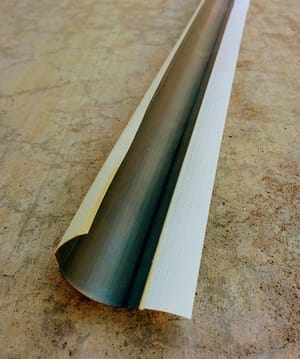
How to Install Drywall Corner Bead
Drywall corner bead is made of either metal or vinyl and serves to protect the outside corners of walls. It is often referred to simply as "bead" because of the thin straight line that is created with the corner of the material. Whether made of metal or vinyl, the material forms as a very small round bead that runs the entire length. One piece is called a stick of corner bead, because it resembles a long rigid stick. Most often corner bead is installed by drywall hangers but at times, drywall tapers will be asked to install it.
Step 1 - Choose what type of corner bead to use.
 Various types of corner bead may be used. Metal bead installed with screws or drywall nails and vinyl bead installed with spray adhesive are probably the most common. The picture displayed here shows vinyl corner bead used on green board (moisture resistant drywall panels).
Various types of corner bead may be used. Metal bead installed with screws or drywall nails and vinyl bead installed with spray adhesive are probably the most common. The picture displayed here shows vinyl corner bead used on green board (moisture resistant drywall panels).
Tape-on metal corner bead is another very good option. It comes as metal corner bead wrapped with paper drywall tape. The paper tape, extends about 1-½ inches past the metal on both sides. This type of corner bead is applied similar to the way you tape drywall seams. Mud is applied to the drywall and the tape is pressed into the drywall mud. Once it is smoothed out, the drywall mud glues it firmly to the corners.
Step 2 - Make sure it is Straight!
Regardless of the type of corner bead used or the method of application, it needs to be put on straight and attached firmly. Drywall crimping tools and/or lasers are sometimes used to ensure the bead goes on straight. Lasers are the best way to ensure that corner bead is installed correctly, but they should only be used by professionals because of the inherent dangers
Drywall Crimping Tools
Some people prefer to use drywall corner bead crimping tools when installing corner bead. The purpose of these tools is to keep the bead of the stick straight and square on the outside corner. They are made so that when you hit the trigger with a hammer, small metal pins in the tool punch the metal corner bead to crimp it into place on the drywall. Corner bead crimping tools can be helpful if used properly. However, crimping tools are only about 16 inches long, so don't expect them to hold the entire stick of bead straight. If you are installing a long stick of corner bead, it is important to stand back and eye-it-up occasionally to make sure it is going on straight. If you are not careful, it could easily rotate gradually along length length.
Crimping tools are NOT meant to securely attach corner bead to outside corners. They simply crimp it into place until some other method is used to attach it to the structure below. Some of these methods are mentioned below.
Step 3 - Install it square to the walls
Corner bead needs not only to be installed straight but also square on both sides. When paying attention to the entire length of the bead, ensuring it is straight, don't forget to make sure it doesn't fold over too far on one side, leaving the other side too shallow. You can tell easily if it is applied square by placing a straightedge at a 90° angle to the bead and notice the gap created . The gap from the bead to the drywall should be even on both sides. If you have a deep cavern on one side but the bead is hitting the straightedge on the other, slide the bead toward the shallow side. If the bead is left shallow on one side it will flash through the drywall mud, making it very difficult for the drywall finishers.
Step 4 - Make sure it is attached firmly
Drywall corner bead must be attached firmly to the underlying structure. Regardless of the method of installation, you need to make sure that the bead will not move in the future. Don't assume that drywall mud will hold it in place. Drywall mud does not have much holding power on it's own and will simply crack if the bead moves at all. If the bead is not securely attached before applying drywall mud, it probably won't get better after it is coated.
Installing Vinyl Corner Bead
Vinyl corner bead is usually installed with spray adhesive. Corner bead spray adhesive is specially designed with tinting to make it easier to see the spots that have no glue. Adhesive should be sprayed on the inside flanges of the corner bead and allowed to set for about 10-15 minutes. Meanwhile the outside drywall corners can be sprayed with adhesive and allowed to set as well. Take care not to miss a spot. If there are any spots of vinyl that do not have glue, they will probably flash or crack after being coated.
When ready, the vinyl bead can be placed on the corner. The spray adhesive will attach quickly so you will only have a few seconds to make sure it is installed straight and square. When done properly, spray adhesive is so strong that it cannot be removed from the drywall without ripping the paper. At times, a compressed air staple gun is also used to give added strength but the spray adhesive is usually good enough on it's own.
Installing Metal Corner Bead
Metal corner bead can be installed with nails, screws or staples. When working with wood studs, nails or staples are the easiest method. Screws must be used on metal studs. One challenge with using metal fasteners on metal bead is the tendency for them to push the bead one direction or another. Although metal corner bead has holes in various locations. You may need to screw directly through the metal on the bead instead of through the pre-punched holes. Drywall tape can also be used, though this is rarely done. However, we have found that metal bead that has been taped on with drywall tape rarely cracks.
Installing Paper Faced Metal Corner Bead
Paper faced metal corner bead is applied with methods very similar to taping drywall seams. Mud is applied to the drywall. Then the paper on each side of the metal bead is pressed into the mud. Excess drywall mud is smoothed out from the edges to ensure a uniform adhesion. Once dry, it can be coated as normal. There are specialized tools to aid in installing paper faced metal corner bead. Corner bead hoppers apply drywall mud to the paper quickly and evenly by simply pulling the bead through the hopper. Hoppers used in conjunction with outside corner rollers help to make installing paper faced metal bead just as fast or sometimes faster than regular metal or vinyl bead.
Bullnose corner bead
Bullnose corner bead is very similar to square corner bead except it has a curved radius instead of a sharp corner. It is used to create rounded outside corners on walls instead of square corners. The principles discussed here apply similarly to bullnose corner bead. One difference is the way drywall is hung on outside corners. When using bullnose, both sheets of drywall are hung to the edge of the stud, rather than one sheet being hung to the edge of the other sheet. This gives the appearance that both sheets are setting back lightly. Doing this leaves room for the curve of the bullnose so that the drywall doesn't hold the bead away from the corner. If using bullnose, it is important to consider what type of baseboard will be used. Some baseboard can be installed around curved corners but it is best to plan this out rather than surprise the finish carpenter who comes to install the molding.
Tearaway vinyl corner bead
Tearaway vinyl corner bead is used to make crisp edges where drywall meets other finish materials such as metal or wood. It is easily applied and finished with a six or eight inch drywall knife.
Flex, composite, metal reinforced, etc
There are also beads available on the market that are described as either flex bead, flexible composite paper bead, metal reinforced paper bead, etc. These products are best used on inside, off-angle, or curving corners. They are not well suited for your standard straight outside corner.
Conclusion
Drywall corner bead is best installed after hanging and before drywall taping begins. There are several types of corner bead available. There are no major advantages of one type of corner bead over another. Learning how to install it straight, square and firm takes time. Once installed corner bead is coated with drywall mud to create beautiful outside drywall corners.






